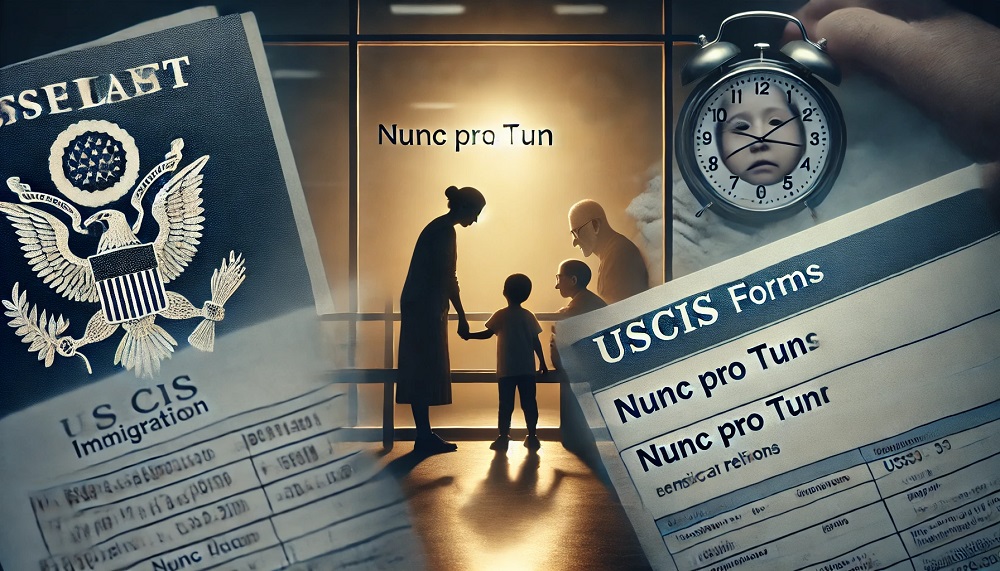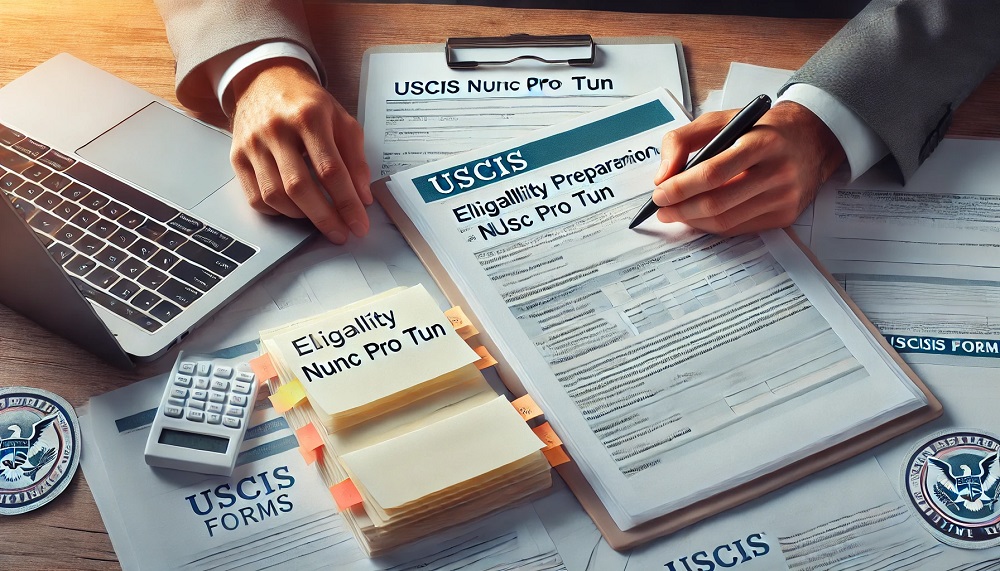You ever miss a USCIS deadline and feel like your whole immigration journey is about to go up in flames? Yeah, it’s terrifying. Whether it’s a delayed visa extension, an F-1 student aging out, or some clerical mess-up by the government—sometimes, things fall through the cracks. And when they do, there’s a little-known legal fix that could save the day: Nunc Pro Tunc.
I know, it sounds like a Harry Potter spell or a Latin curse. But it’s actually a real legal doctrine that means “now for then.” In simple terms, it’s a way to ask USCIS, “Can you pretend this was done correctly… back when it should have been?” And in some cases? They say yes.
This isn’t a loophole or some shady trick. It’s built into the system to correct honest mistakes—especially when people suffer through no fault of their own. Think government delays, miscommunications, or just plain bad luck.
According to immigration attorneys, nunc pro tunc relief is rare, but it’s not impossible. If you’ve been stuck in limbo because of a status gap or age-out issue, you might just have a shot at fixing it—retroactively.
In this guide, we’ll break down everything you need to know: what a USCIS nunc pro tunc case is, when it’s used, who qualifies, and how to file it right. Let’s get into it.
What Is Nunc Pro Tunc in Immigration? 🤔
Alright, let’s decode this legal tongue-twister—because it sounds fancy, but it can actually be a lifeline if you’re stuck in an immigration mess.
🧠 What Does “Nunc Pro Tunc” Even Mean?
Nunc pro tunc is Latin for “now for then.” In the world of immigration law, it basically means asking USCIS to pretend something was filed or approved earlier than it really was. So if you missed a deadline or your visa status lapsed, this legal tool lets you ask for retroactive approval—like rewinding time and correcting the record.
It’s not just a formality. When granted, it can mean the difference between staying in legal status or having to leave the U.S.
⚖️ How It Works in Immigration Context
In court, nunc pro tunc is used to fix clerical errors. But with USCIS, it’s more than paperwork—it’s about fixing status issues. Think of it like this: You’re applying for a change or extension of status, but it gets delayed or denied due to circumstances beyond your control. With a nunc pro tunc request, you’re asking USCIS to approve your request as if it were done on time.
This is not a loophole for procrastination. You have to show that the mistake wasn’t your fault and that you’ve been in the U.S. the whole time.
📌 Real-World Example
Let’s say you’re an F-1 student. You submit your change of status to H-1B, but USCIS doesn’t process it before your student status expires. Now you’re in limbo. If you’ve stayed in the U.S. and can show extreme hardship or government delay, you might request a nunc pro tunc approval—to treat that H-1B as if it was approved on time.
Or here’s another one: your child turns 21 while waiting for your green card application to move. Under the Child Status Protection Act (CSPA), there’s limited wiggle room. But if the timeline doesn’t work out, a nunc pro tunc request might help preserve their eligibility by pretending they were still under 21 when the petition was “approved.”
🚫 What It’s Not For
Let’s be clear: this isn’t a free pass. It’s not meant for folks who just forgot to file or ignored deadlines. USCIS takes these requests seriously—and they only grant them when there’s a strong case of fairness, hardship, or error.
To recap:
-
You must be physically present in the U.S. when you request it
-
You can’t have committed fraud or violated your status intentionally
-
You’ll need solid documentation to prove your case
So yes, nunc pro tunc might sound like legal jargon, but it’s really a tool for fairness—designed to help folks who got caught in the cracks of a complicated immigration system. If you’re in that boat, it’s worth exploring.
Common Scenarios Where Nunc Pro Tunc Relief May Apply 💼

Okay, so now that you get what nunc pro tunc is, the big question is: When can you actually use it? It’s not some magic trick you can pull out anytime—but in a few key situations, it can totally save your immigration case.
Let’s walk through some real-life scenarios where USCIS might say, “Alright, we’ll backdate that for you.”
🕒 1. USCIS Took Too Long (Yep, It Happens)
Ever sent in your change of status on time, only to hear crickets from USCIS for months? Happens all the time. You followed the rules, but now your original visa expired, and you’re suddenly out of status.
In cases like this, a nunc pro tunc request says, “Hey, I did my part. Don’t punish me for the delay.” And if you’ve stayed in the U.S. and avoided any violations, they might grant it.
✅ Best for: F-1 to H-1B, H-1B extensions, H-4 dependents, I-539 delays
👶 2. Aging Out of Eligibility (The 21-Year Cliff)
This one breaks a lot of hearts. A child dependent on your visa (like an H-4 or F-2) turns 21 while you’re waiting on green card processing. Suddenly they’re no longer considered a “child” under immigration law and can’t piggyback on your application.
In some rare cases, if there were delays outside your control, a nunc pro tunc request can ask USCIS to treat the petition like it was approved before their birthday. That way, your kid doesn’t fall through the cracks.
✅ Best for: Green card applicants with children close to aging out
🗃️ 3. Administrative Errors or Bad Advice
Here’s where things get messy. Let’s say your attorney forgot to file something. Or USCIS misplaced a document. Maybe a government agent told you the wrong thing over the phone (yes, it happens). And now you’re out of status or got denied.
You can use a nunc pro tunc request to argue that the error wasn’t your fault and that you should still be eligible—because the intent was always there.
✅ Best for: Mistaken denials, lost applications, bad legal advice
🛂 4. Falling Out of Status During a Good-Faith Wait
Some folks stay in the U.S. waiting for a decision and don’t realize their underlying visa expired in the meantime. If you didn’t overstay intentionally and can prove you’ve been doing everything by the book, USCIS might be willing to grant nunc pro tunc approval.
✅ Best for: TPS, DACA, F-1 reinstatement, employment-based cases
🧍♂️ 5. Nunc Pro Tunc For Asylum (Derivatives, Typically)
The Situation:
Say a parent was granted asylum, and their spouse or child was included as a derivative asylee. Everyone’s on track, living in the U.S., waiting the one-year mark to file for green cards (adjustment of status under INA 209). But before the derivative files Form I-485, the principal asylee naturalizes and becomes a U.S. citizen.
Here’s the problem: Once the principal becomes a citizen, USCIS considers that person no longer an “asylee,” and the derivative’s eligibility to adjust under asylum law disappears.
Basically, the government says: “Oops, your anchor no longer qualifies as an asylee, so now you can’t get a green card through them.” 😳
How Nunc Pro Tunc Helps:
In this case, a derivative can file a nunc pro tunc I-485, asking USCIS to treat the green card application as though it was filed before the principal naturalized. The logic is: the derivative was eligible, ready to apply, and did nothing wrong—timing just didn’t work out.
What Needs to Be Shown:
-
The principal was an asylee at the time the derivative would have applied
-
The delay wasn’t the derivative’s fault
-
The relationship (e.g., parent/child or spouse) existed during eligibility
-
There’s hardship or risk if lawful status isn’t granted
✅ Best for: Derivative children or spouses who missed adjustment window after principal’s naturalization
🚫 But If You Just Forgot?
Sorry, that won’t cut it. USCIS isn’t here for “Oops, I didn’t know I had to renew that.” You need more than forgetfulness—you need hardship, good faith, and clear documentation to back it all up.
If any of these situations sound like you, talk to an immigration attorney ASAP. Nunc pro tunc relief is rare—but it’s real. And if used right, it can change your entire future.
Eligibility Requirements for USCIS Nunc Pro Tunc Requests ✅

Alright, so we’ve covered what nunc pro tunc is and when it might apply. But before you start prepping your forms and firing off letters to USCIS, you gotta make sure you actually qualify. Because trust me, they don’t hand these out like stickers at the DMV.
Let’s break down what boxes you need to check to be considered.
🧍♀️ 1. You Must Still Be Physically Present in the U.S.
This one’s huge. USCIS only grants nunc pro tunc relief if you’re currently in the U.S. If you’ve already left the country, even accidentally, your request is dead on arrival. So yeah, don’t fly out for a cousin’s wedding thinking you can file from abroad.
📌 Tip: If you’re near the end of your authorized stay and think you may need nunc pro tunc, stay put and get legal advice ASAP.
📄 2. You Filed Something… Just Not on Time
You can’t just show up outta nowhere and ask for a do-over. You need to show that you already submitted an application or petition, but it either:
-
Was rejected for a technical reason (like missing a signature),
-
Was filed late due to circumstances beyond your control,
-
OR was delayed by USCIS’s own backlog or mismanagement.
❤️ 3. There’s Some Serious Hardship Involved
USCIS isn’t just looking for a sob story—they’re looking for real, documented hardship. We’re talking:
-
You’d lose your ability to stay with your family,
-
You’d get banned from the U.S. for overstaying,
-
Or you’d be forced back to a dangerous situation in your home country.
Basically, they want to know that denying your nunc pro tunc request would wreck your life in some measurable way.
📚 4. You’ve Been Compliant and Honest (Mostly)
You don’t have to be perfect, but you can’t be shady either. You should be able to show:
-
You were in valid status before the issue came up,
-
You didn’t willfully break immigration laws,
-
You didn’t lie on forms or commit fraud.
A little mess-up? Maybe forgivable. But if you ghosted ICE or submitted fake documents… yeah, you’re not getting nunc pro tunc.
🧾 5. Your Documentation Is Rock Solid
You’ll need to bring receipts—a lot of them:
-
Proof of your previous status (I-94, visa stamps, old approvals)
-
Copy of your denied or delayed application
-
Letters explaining the hardship
-
Maybe even a legal memo from an attorney backing your argument
🗂️ Pro Tip: Organize everything like it’s going in front of the toughest judge you can imagine. Neat, labeled, and airtight.
Bottom line? If you’re still in the U.S., tried to do the right thing, and got sideswiped by delays or bureaucracy, you might qualify for this relief. But you’ve gotta make the case strong, clear, and heartfelt.
How to File a Nunc Pro Tunc Request with USCIS 📝

Okay, deep breath. This is where it starts to feel real. Filing a nunc pro tunc request with USCIS isn’t like clicking “submit” on a regular form. It’s more like writing a legal story—one where you have to prove why your case deserves a rewind.
Don’t worry, I’ve got you covered. Let’s walk through what you’ll need, step by step.
📬 Step 1: Know What You’re Requesting (And Why)
Before you do anything else, be super clear on what action you’re asking USCIS to take retroactively.
Examples:
-
“Please approve my I-539 change of status as of March 15, 2023.”
-
“Please treat my I-485 as timely filed and effective as of the date my priority date became current.”
The ask needs to be direct, specific, and grounded in actual immigration law.
💡 Tip: Don’t just say “please help.” Be clear: what status are you fixing? What mistake are you correcting?
🧾 Step 2: Gather Your Supporting Docs (Seriously, Everything)
Now it’s time to stack that paperwork. USCIS wants to see the whole story—and proof that you were doing your best all along.
Here’s what you’ll likely need:
-
A detailed cover letter explaining your case
-
A timeline of what happened (dates matter!)
-
Copy of the form you previously filed (like I-539, I-485, I-130, etc.)
-
Any receipts, notices, RFEs, or denial letters
-
Affidavits explaining delays (from you or your attorney)
-
Hardship evidence (medical records, family separation, financial loss, etc.)
-
Your most recent I-94 and entry documents
-
A copy of any relevant regulations or case law that supports your ask
📎 Pro Tip: Put it all in order and label it clearly. USCIS officers are human—they’ll appreciate being able to follow your story without digging.
🧠 Step 3: Add a Legal Memo (If You Can)
If you’re working with an immigration lawyer—and honestly, for this kind of case, you should be—they’ll write a legal brief or memorandum of law.
This memo connects your facts to actual immigration law and past case decisions where nunc pro tunc was granted.
Not required… but it definitely helps.
📤 Step 4: File with the Right Form & Service Center
The form you’re attaching your nunc pro tunc request to depends on your case:
-
For reinstating status: I-539
-
For appealing or reopening a denial: I-290B
-
For a green card adjustment issue: I-485 or I-130
File with the same USCIS service center where your original case was submitted unless instructed otherwise.
Oh—and label your cover letter bold and clear:
“NUNC PRO TUNC REQUEST ENCLOSED”
⏳ Step 5: Wait… and Maybe Wait Some More
There’s no set timeline for nunc pro tunc decisions. Some people hear back in a few months. Others? It’s crickets for a year or more.
Follow up. Politely. And be patient. If your situation gets worse while you’re waiting (like a new hardship pops up), consider sending in updated evidence.
Filing a nunc pro tunc request is not a one-size-fits-all deal. It’s part legal argument, part personal plea. But when done right, it can get your status back on track—like the mistake never happened.
USCIS Nunc Pro Tunc Case Processing Timeline and Outcomes ⏳

Okay, so you’ve filed your nunc pro tunc request, sent off that mountain of paperwork, and now… you wait. And wait. And wait some more. 🙃
The truth? There’s no official timeline for these cases. But here’s what to expect so you don’t lose your mind during the process.
⌛ How Long Does It Take?
Honestly? It depends. Some people hear back in 3 to 6 months, others wait over a year. USCIS doesn’t give priority to nunc pro tunc requests, and since these are case-by-case discretionary decisions, there’s no fast lane.
The timeline usually depends on:
-
Service center workload
-
Complexity of the request
-
Whether you filed it with a pending petition (like an I-485)
-
If an RFE (Request for Evidence) is issued
💬 Real talk: Some folks never hear back unless they push or escalate through their lawyer or congressional help.
📨 What Kinds of Responses Might You Get?
USCIS can reply in a few ways:
✅ Approval
You’ll get a notice that your petition was granted nunc pro tunc. The approval date will be backdated, restoring or preserving your status. This is the goal! 🎉
🧾 RFE (Request for Evidence)
They might ask for more documents—usually to clarify hardship, status history, or missing forms. Take this as a good sign that they’re actively considering your case.
❌ Denial
Unfortunately, some requests are denied. Reasons may include:
-
Lack of hardship
-
Missed eligibility
-
Insufficient documentation
-
You left the country before filing
You might still have options after a denial, like filing a motion to reopen or appealing through an I-290B.
📬 Can You Follow Up or Expedite?
Yes, but you gotta do it carefully. You or your lawyer can:
-
Submit a case status inquiry
-
Call the USCIS customer service number
-
Request congressional assistance (your senator or rep’s office can help)
-
Ask for an expedite in extreme hardship cases, with supporting docs
📢 Tip: Don’t be afraid to respectfully follow up every 90 days. Politely remind them your life is on hold.
💡 What Happens If It’s Approved?
If USCIS grants your request:
-
Your status is restored as if the approval was always timely
-
You avoid unlawful presence or age-out penalties
-
You can move forward with future applications confidently
And best of all? You get peace of mind knowing that one major screw-up is now legally corrected.
Bottom line: Be patient, be persistent, and stay ready to respond. Nunc pro tunc cases take time—but they can absolutely change lives when approved.
Real-Life Examples of Successful USCIS Nunc Pro Tunc Cases 🎯

Let’s face it—immigration law is filled with “what ifs” and “maybe it’ll work” scenarios. So when someone actually gets a nunc pro tunc request approved? That’s worth studying.
These aren’t fairy tales—just real people who got caught in the system but found a way out thanks to nunc pro tunc relief.
👨🎓 F-1 Student Reinstated After Status Lapse
The Situation:
Raj was an international student whose SEVIS record was terminated after he dropped below a full course load due to a medical emergency. He filed a reinstatement request, but it was rejected because he had been out of status too long.
What Worked:
His attorney submitted a nunc pro tunc reinstatement request along with medical documentation and a psychological evaluation. They explained that Raj’s condition prevented him from understanding the consequences of his actions.
Outcome:
USCIS approved the request nunc pro tunc and restored his F-1 status as of the date he had originally lost it. He’s now finishing his master’s degree.
👶 H-4 Child Aged Out During Green Card Process
The Situation:
Maria’s 20-year-old son was listed as a derivative on her employment-based green card petition. Due to long USCIS processing delays, he turned 21 before the I-485 could be approved.
What Worked:
The lawyer filed a nunc pro tunc I-485 application just for her son, requesting USCIS treat it as timely filed under the Child Status Protection Act (CSPA). They argued that the delay was entirely out of their control.
Outcome:
After six months and a couple of follow-ups, USCIS approved the son’s green card nunc pro tunc, preserving his status as a derivative beneficiary.
🧾 TPS Applicant With Expired Status Gets Relief
The Situation:
Jorge, a TPS recipient from El Salvador, missed renewing his work permit and fell out of status. His employer was ready to sponsor him for a green card, but his lapse in status made adjustment risky.
What Worked:
An experienced immigration lawyer submitted a nunc pro tunc motion with an I-485 package. They documented Jorge’s continuous residence, tax filings, family hardship, and explained the delay was due to attorney error.
Outcome:
USCIS approved the motion, and Jorge’s adjustment went through as if he’d maintained TPS continuously. He’s now a permanent resident.
🛑 Bonus: A Case That Didn’t Work (And Why)
The Situation:
A software engineer tried to file nunc pro tunc after letting their H-1B expire by six months. No explanation, no lawyer—just mailed in a letter.
Why It Failed:
There was no documented hardship, no compelling reason, and no legal support. USCIS denied the request and noted that discretion is only used in exceptional situations.
💬 The Lesson?
Nunc pro tunc isn’t about luck—it’s about strategy, documentation, and timing. And almost always? It’s about having a lawyer who knows how to frame the story legally and emotionally.
Legal Risks, Limitations, and Strategy Considerations 🚨

Okay, time to keep it real. Nunc pro tunc sounds great when it works—and it can work. But this isn’t one of those “just send a form and hope for the best” deals. There are risks. There are limitations. And if you don’t approach it strategically, you could end up worse off than when you started.
Let’s talk about what to watch out for.
🚫 It’s Not a Guaranteed Fix
Just because your situation feels unfair doesn’t mean USCIS will agree. These requests are entirely discretionary. That means even if you meet every technical requirement, they can still say “no thanks.”
They’re looking for:
-
Good faith effort to follow the rules
-
A real, documentable reason things went sideways
-
A compelling reason to grant you retroactive relief
If any one of those is shaky? Denial is likely.
🧭 It’s Case-by-Case, and There’s No Formal Process
Unlike other immigration forms that come with checklists and instructions, nunc pro tunc is a bit of a gray area. There’s no standardized form, no published USCIS timeline, and no specific filing fee.
Everything depends on:
-
Your story
-
Your documentation
-
Your legal argument
🎯 Strategy Tip: Treat it like a legal motion, not a casual request. The more structured and compelling your case looks, the better.
🔄 You Might Accidentally Trigger Unlawful Presence
Here’s a risk people don’t talk about enough: if your request gets denied, and you’re already out of status, you may have accumulated unlawful presence. That could lead to:
-
Bars on re-entry (3-year, 10-year)
-
Trouble with future visa applications
-
Ineligibility for adjustment
⚠️ If you’re already out of status, talk to a lawyer before filing anything.
🧑⚖️ Some Issues Simply Aren’t Fixable Nunc Pro Tunc
This fix doesn’t apply to:
-
Fraudulent filings
-
Voluntary departure situations
-
People who left the U.S. before filing
-
Reinstating nonimmigrant intent in immigrant visa filings
In those cases, you may need to explore waivers, consular processing, or re-entry strategies instead.
🤝 Work With an Attorney Who’s Done It Before
This is not DIY territory. You’re arguing with the government to bend time—and rules—on your behalf. One missing page or weak explanation can sink your shot.
Find an attorney who:
-
Has filed successful nunc pro tunc requests
-
Understands USCIS discretion
-
Knows how to package hardship + legal citations effectively
💡 Tip: Ask them how many nunc pro tunc cases they’ve filed and what their outcomes were.
🧠 Bottom Line?
Nunc pro tunc is like the legal version of “let’s pretend that never happened.” But you can’t go in blind. Know the risks, build your case with intention, and don’t wing it.
When used smartly, it can save your immigration future. But used poorly? It can close doors you didn’t even know were open.
Conclusion: Turning Back Time—When It Counts Most ⏮️✨
If you’ve made it this far—congrats! You now know more about USCIS nunc pro tunc cases than 99% of people navigating immigration issues.
At its core, nunc pro tunc is a rare but powerful legal tool. It’s not a magic wand, but it can rewind the clock in the eyes of USCIS—fixing missed deadlines, preserving legal status, and even saving green card dreams for kids who aged out or workers who slipped through the cracks.
But let’s not sugarcoat it. This process is complex, high-stakes, and absolutely not something you want to DIY from a random forum post. It requires airtight documentation, a compelling legal and emotional case, and often an attorney who knows this niche cold.
So, if you’re dealing with a status gap, USCIS delay, or visa fallout that you genuinely tried to avoid—this might be your shot. It’s a narrow path, sure. But it’s there. And when it works? It can literally change lives.
💬 Final Tip:
Talk to an immigration attorney who has filed and won nunc pro tunc cases before. Ask questions, push for clarity, and make sure your story is told the right way. Because sometimes, the system allows for second chances. You just have to know how to ask.
📚 Further Reading & Official Resources
-
USCIS Policy Manual – Discretionary Relief and Motions
https://www.uscis.gov/policy-manual/volume-1-part-e-chapter-8 -
AILA – Practice Advisory: Nunc Pro Tunc Motions (American Immigration Lawyers Association – membership may be required)
https://www.aila.org/library/practice-advisory-nunc-pro-tunc-motions -
BIA Decision on Nunc Pro Tunc (Matter of Luviano, 2004)
https://www.justice.gov/eoir/vll/intdec/vol25/3502.pdf -
Legal Aid at Work – Nunc Pro Tunc Immigration Overview
https://legalaidatwork.org/factsheet/nunc-pro-tunc-immigration/ -
USCIS – How to File Form I-290B (Motion to Reopen or Reconsider)
https://www.uscis.gov/i-290b -
Immigrant Legal Resource Center – Nunc Pro Tunc Options for TPS Holders
https://www.ilrc.org/nunc-pro-tunc-options-tps-holders
